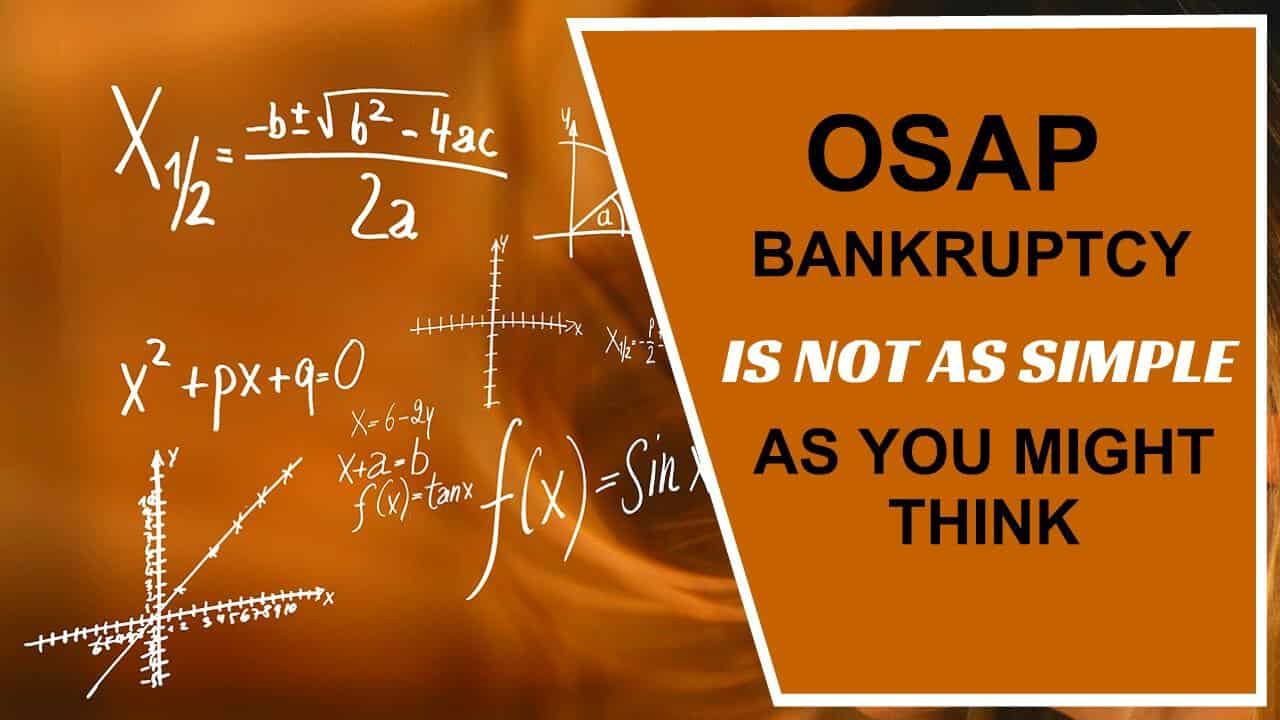OSAP bankruptcy Introduction
I have written before on the issue of the difficulty in discharging student loans through bankruptcy. Bankruptcy will certainly not release your student loans debt until you’ve been out of full or part-time studies for 7 years. It is also question and answer #8 in our TOP 20 PERSONAL BANKRUPTCY FAQS found on our main website. In Brandon’s Blog, I want to drill down into the issue of an OSAP bankruptcy.
What is OSAP?
The Ontario Student Assistance Program (OSAP) is a financial assistance program that can assist students in spending for college or university.
OSAP provides money via:
- Grant: cash you do not need to repay
- Loan: a loan you are required to pay off when you’re done college or university
OSAP can assist your spending for:
- tuition
- books and supplies/equipment
- student fees billed by an institution
- living expenditures
- childcare
Amongst the various categories of people who are not eligible for OSAP, one is those people who have filed for either personal bankruptcy or a consumer proposal. As you might imagine, the rules surrounding OSAP bankruptcy are not simple. Let’s do some drilling down now!
Students that did not get student loans before the day they declared bankruptcy or filed a consumer proposal
If the student has been discharged from bankruptcy or fully completed a consumer proposal, she or he does not require to offer any type of supporting paperwork in order for their OSAP application to be reviewed.
If the student is an undischarged bankrupt or has not completed the consumer proposal, the student must supply a letter from their licensed insolvency trustee (formerly called a bankruptcy trustee) or consumer proposal administrator. The document must show the day the student filed for either bankruptcy or the consumer proposal and that these 2 matters have actually been or will be satisfied:
- Ontario and Canada is not a creditor in the bankruptcy or consumer proposal as an outcome of monetary help provided via OSAP; and
- no monetary help offered to the student via OSAP during the current OSAP year will be taken in the insolvency proceedings to pay back the creditors
Discharged and the student is not presently enrolled in studies
If the student is discharged from bankruptcy or has successfully completed a consumer proposal, his/her OSAP application will not be decided upon until the student gives evidence that they have no amount owing on any student loans.
Alternatively, if applicable, the student can show that he/she received relief in their bankruptcy by way of a court order stating that section 178(1)(g) of the Bankruptcy and Insolvency Act (Canada) (BIA) no longer applies to the student loans.
In this situation, the student needs to supply:
- evidence that an order of discharge or full completion of the consumer proposal has been achieved and that 3 years have expired since that date
- a copy of the notice of bankruptcy/consumer proposal
- letter from the student’s bank and/or the National Student Loans Service Centre confirming there is no outstanding balance
- any relevant court order
Discharged and continuing a program of study
If the student is discharged from bankruptcy or has successfully completed a consumer proposal, his/her OSAP application will not be decided upon until the student gives evidence that they have no amount owing on any student loans.
Alternatively, if applicable, the student can show that he/she received relief in their bankruptcy by way of a court order stating that section 178(1)(g) of the BIA no longer applies to the student loans.
In this situation, the student needs to prove that he/she meets all of the following criteria:
- at the time the student declared bankruptcy or filed the consumer proposal, they were enrolled in an accepted program of study at an accepted school and taking the minimum called for course load
- the student remains in the same accepted program they were in on the date of bankruptcy/consumer proposal filing date
- the student has not had a break in studies longer than 6 months since the date of bankruptcy/consumer proposal filing date
- it has not been greater than 3 fiscal years since the date of bankruptcy/consumer proposal filing date
In this situation, the student needs to supply:
- evidence that an order of discharge or full completion of the consumer proposal has been achieved and that 3 years have expired since that date
- a copy of the notice of bankruptcy/consumer proposal
- letter from the student’s bank and/or the National Student Loans Service Centre confirming there is no outstanding balance
- any relevant court order
- letter from the student’s Financial Aid Office verifying that the program of study in which the student was registered at the time of the bankruptcy/consumer proposal filing, is the same as the program the student is now applying for
Undischarged bankrupt or has not yet fully completed the consumer proposal
If the student is an undischarged bankrupt or has not successfully completed a consumer proposal, the processing of the student’s OSAP application will not be completed until the student gives evidence that they have no amount owing on any student loans.
In this situation, the student needs to prove that he/she meets all of the following criteria:
- at the time the student declared bankruptcy or filed the consumer proposal, they were enrolled in an accepted program of study at an accepted school and taking the minimum called for course load
- the student remains in the same accepted program the were in on the date of bankruptcy/consumer proposal filing date
- the student has not had a break in studies longer than 6 months since the date of bankruptcy/consumer proposal filing date
- it has not been greater than 3 fiscal years since the date of bankruptcy/consumer proposal filing date
In this situation, the student needs to supply a letter from their licensed insolvency trustee or consumer proposal administrator. The document must show the day the student filed for either bankruptcy or the consumer proposal and that these 2 matters have actually been or will be satisfied:
- Ontario and Canada is not a creditor in the bankruptcy or consumer proposal as an outcome of monetary help provided via OSAP; and
- no monetary help offered to the student via OSAP during the current OSAP year will be taken in the insolvency proceedings to pay back the creditors
The student will also need to supply a:
- letter from the student’s bank and/or the National Student Loans Service Centre confirming there is no outstanding balance
- any relevant court order
- letter from the student’s Financial Aid Office verifying that the program of study in which the student was registered at the time of the bankruptcy/consumer proposal filing, is the same as the program the student is now applying for
Summary
I hope you now understand that the whole area of OSAP bankruptcy and student loans in either a bankruptcy or consumer proposal is not as simple as you might have originally thought. This is especially the case if the student is continuing his or her studies.
Do you have too much debt? Are you in financial distress? Do you not have adequate funds to pay your financial obligations as they come due?
If so, call the Ira Smith Team today. We have decades and generations of experience assisting people looking for financial restructuring, a debt settlement plan and to AVOID bankruptcy.
As a licensed insolvency trustee (formerly called a bankruptcy trustee), we are the only professionals accredited, acknowledged and supervised by the federal government to provide insolvency advice and to implement approaches to help you remain out of personal bankruptcy while eliminating your debts. A consumer proposal is a government approved debt settlement plan to do that. We will help you decide on what is best for you between a consumer proposal vs bankruptcy.
Call the Ira Smith Team today so you can eliminate the stress, anxiety, and pain from your life that your financial problems have caused. With the one-of-a-kind roadmap, we develop just for you, we will immediately return you right into a healthy and balanced problem-free life.
You can have a no-cost analysis so we can help you fix your troubles. Call the Ira Smith Team today. This will allow you to go back to a new healthy and balanced life, Starting Over Starting Now.





